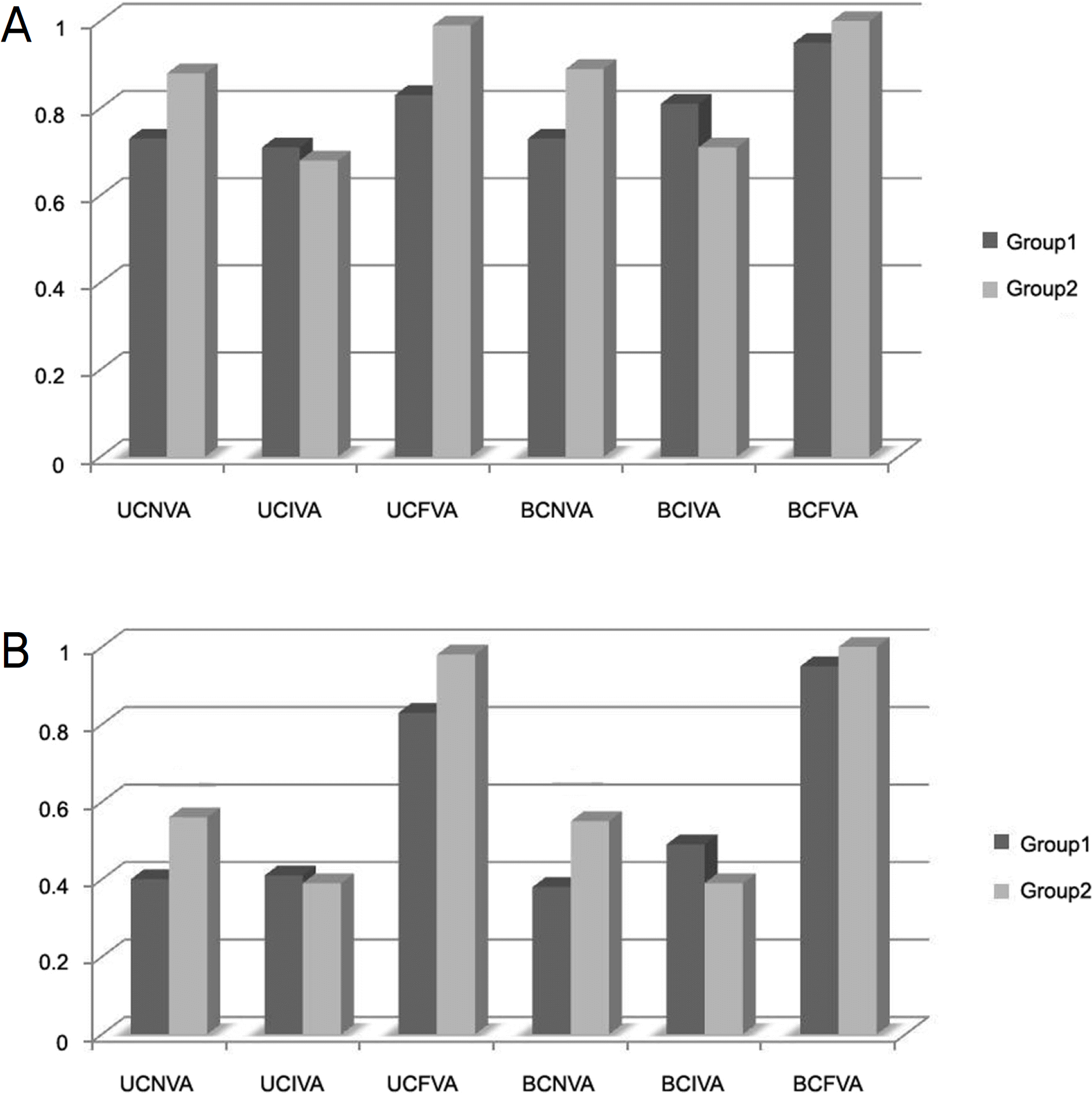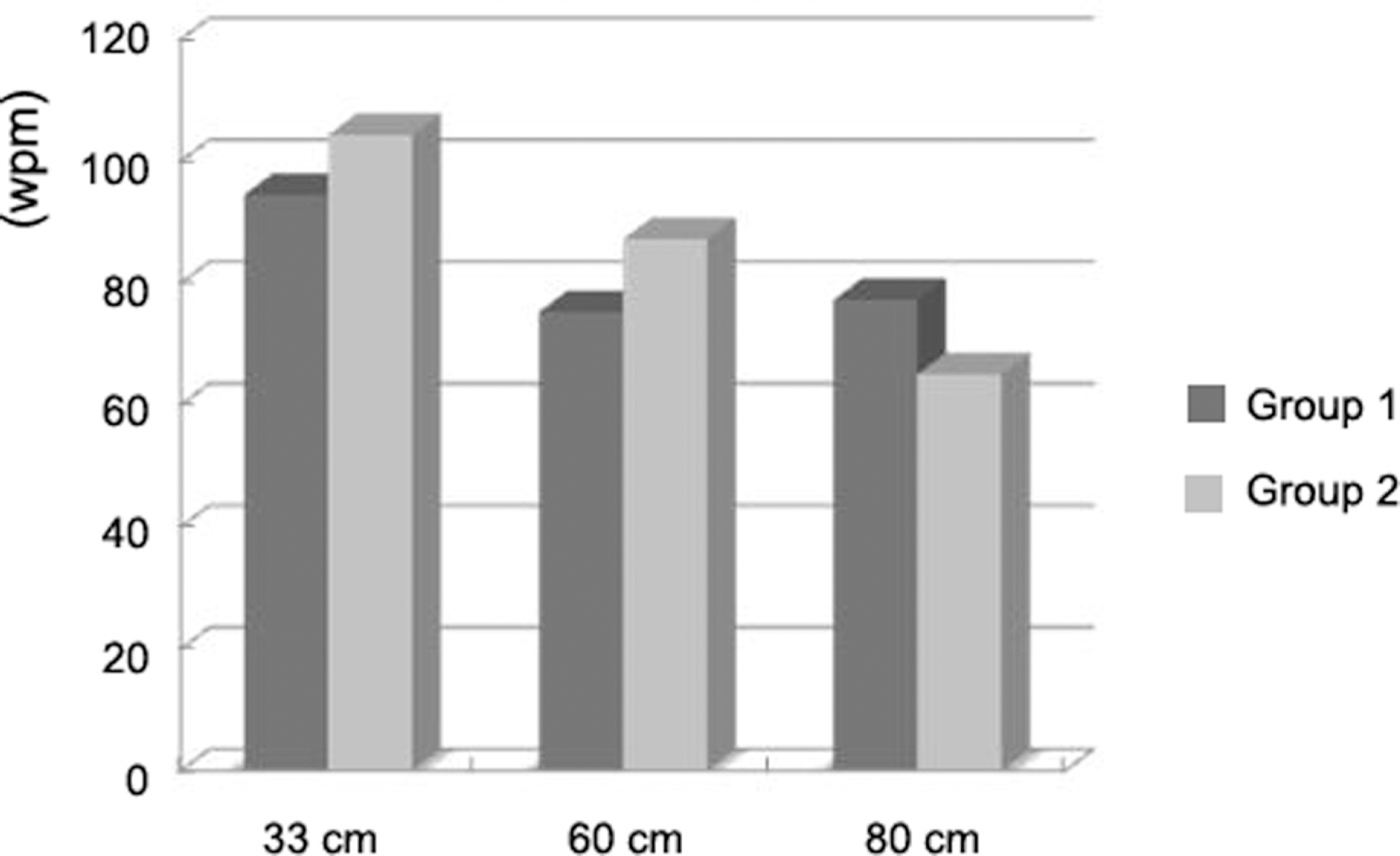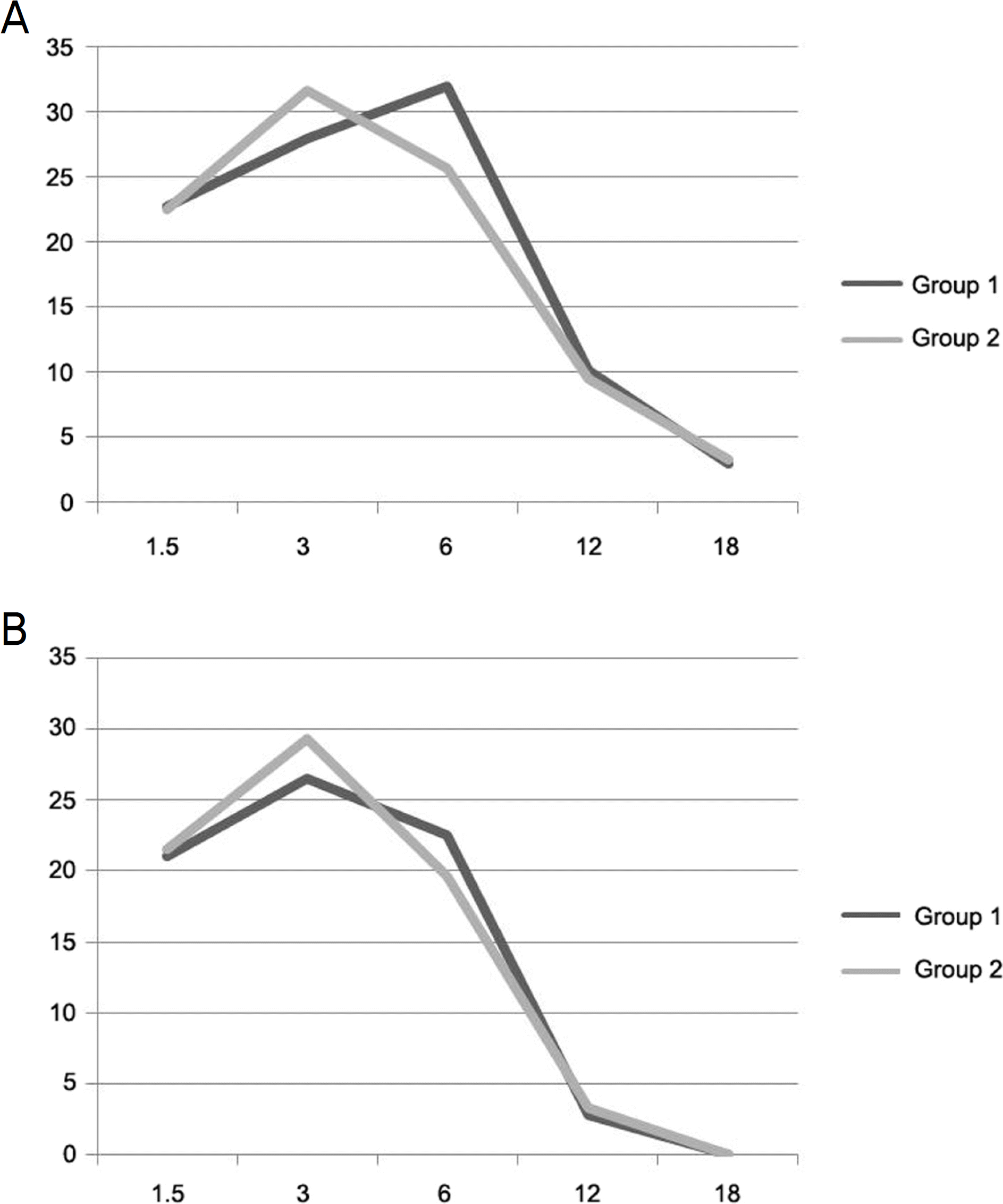Abstract
Purpose
To assess binocular visual outcomes in patients who were implanted with a monofocal IOL (intraocular lens) in one eye and a multifocal IOL in the contralateral eye or with a bilateral multifocal IOL.
Methods
This study enrolled 15 patients (30 eyes) implanted with a monofocal IOL in one eye and a multifocal IOL in the contralateral eye (5 patients, group 1) or with a bilateral multifocal IOL (10 patients, group 2). Binocular visual acuity (uncorrected/best distance corrected near, intermediate, and distance vision), binocular uncorrected reading speed, and contrast sensitivity were assessed at 6 months following the last implantation. Patient's quality of life (overall satisfaction, halos and glare presence, and spectacle dependence) was also assessed using a questionnaire at 6 months postoperatively.
Results
There was significant difference in the uncorrected and corrected near visual acuity between the 2 groups in the mesopic condition. There was no significant difference in visual acuity, reading speed and contrast sensitivity in other conditions between the 2 groups. Spectacle dependence rate was 60% in group 1 and 20% in group 2. The glare symptom was present in 60% of patients in both groups and the halo symptom was present in 3 out of 10 patients in group 2. Overall satisfaction score was not significantly different between the groups.
Go to : 
References
1. Lane SS, Morris M, Nordan L, et al. Multifocal intraocular lenses. Ophthalmol Clin North Am. 2006; 19:89–105.
2. Hutz WW, Eckhardt HB, Rohrig B, Grolmus R. Reading ability with 3 multifocal intraocular lens models. J Cataract Refract Surg. 2006; 32:2015–21.
3. Kohnen T, Allen D, Boureau C, et al. European multicenter study of the AcrySof ReSTOR apodized diffractive intraocular lens. Ophthalmology. 2006; 113:578–84.

4. Blaylock JF, Si Z, Vickers C. Visual and refractive status at different focal distances after implantation of the ReSTOR multifocal intraocular lens. J Cataract Refract Surg. 2006; 32:1464–73.

5. Chiam PJ, Chan JH, Aggarwal RK, Kasaby S. ReSTOR intraocular lens implantation in cataract surgery: quality of vision. J Cataract Refract Surg. 2006; 32:1459–63.

6. Sallet G. Refractive outcome after bilateral implantation of an apodized diffractive intraocular lens. Bull Soc Belge Ophtalmol. 2006; 299:67–73.
7. Souza CE, Muccioli C, Soriano ES, et al. Visual performance of AcrySof ReSTOR apodized diffractive IOL: a prospective comparative trial. Am J Ophthalmol. 2006; 141:827–32.

8. Cumming JS, Colvard DM, Dell SJ, et al. Clinical evaluation of the Crystalens AT-45 accommodating intraocular lens: results of the U.S. Food and Drug Administration clinical trial. J Cataract Refract Surg. 2006; 32:812–25.
9. Gunenc U, Celik L. Long-term experience with mixing and matching refractive Array and diffractive CeeOn multifocal intraocular lenses. J Refract Surg. 2008; 24:233–42.

10. Goes FJ. Visual results following implantation of a refractive multi-focal IOL in one eye and a diffractive multifocal IOL in the contralateral eye. J Refract Surg. 2008; 24:300–5.

11. Sen HN, Sarikkola AU, Uusitalo RJ, Laatikainen L. Quality of vision after AMO Array multifocal intraocular lens implantation. J Cataract Refract Surg. 2004; 30:2483–93.

12. Steinert RF, Post CT Jr, Brint SF, et al. A prospective, randomized, double-masked comparison of a zonal-progressive multifocal intraocular lens and a monofocal intraocular lens. Ophthalmology. 1992; 99:853–60.

13. Percival SP, Setty SS. Prospectively randomized trial comparing the pseudoaccommodation of the AMO Array multifocal lens and a monofocal lens. J Cataract Refract Surg. 1993; 19:26–31.

14. Jacobi PC, Konen W. Effect of age and astigmatism on the AMO Array multifocal intraocular lens. J Cataract Refract Surg. 1995; 21:556–61.

15. Javitt JC, Wang F, Trentacost DJ, et al. Outcomes of cataract extraction with multifocal intraocular lens implantation: functional status and quality of life. Ophthalmology. 1997; 104:589–99.
16. Javitt JC, Steinert RF. Cataract extraction with multifocal intraocular lens implantation: a multinational clinical trial evaluating clinical, functional, and quality-of-life outcomes. Ophthalmology. 2000; 107:2040–8.
17. Jacobi PC, Dietlein TS, Luke C, Jacobi FK. Multifocal intraocular lens implantation in prepresbyopic patients with unilateral cataract. Ophthalmology. 2002; 109:680–6.

18. Cillino S, Casuccio A, Di Pace F, et al. One-year outcomes with new- generation multifocal intraocular lenses. Ophthalmology. 2008; 115:1508–16.
19. Mayer S, Böhm T, Häberle H, et al. Combined implantation of monofocal and multifocal intraocular lenses for presbyopia correction in cataract patients. Klin Monatsbl Augenheilkd. 2008; 225:812–7.
20. Vingolo EM, Grenga P, Iacobelli L, Grenga R. Visual acuity and contrast sensitivity: AcrySof ReSTOR apodized diffractive versus AcrySof SA60AT monofocal intraocular lenses. J Cataract Refract Surg. 2007; 33:1244–7.

21. Lee JM, Seo KY, Kim EK. Comparison of optical aberrations and contrast sensitivity between monofocal and multifocal intraocular lens. J Korean Ophthalmol Soc. 2002; 43:1882–6.
22. Song MJ, Lee MK, Park BI. A Clinical study of 3M multifocal intraocular lens implant. J Korean Ophthalmol Soc. 1991; 32:234–40.
23. Monte's-Mico' R, Espana E, Bueno I, et al. Visual performance with multifocal intraocular lenses mesopic contrast sensitivity under distance and near conditions. Ophthalmology. 2004; 111:85–96.
24. Schmitz S, Dick HB, Krummenauer F, et al. Contrast sensitivity and glare disability by halogen light after monofocal and multifocal lens implantation. Br J Ophthalmol. 2000; 84:1109–12.

25. Allen ED, Burton RL, Webber SK, et al. Comparison of a diffractive bifocal and a monofocal intraocular lens. J Cataract Refract Surg. 1996; 22:446–51.

26. Rossetti L, Carraro F, Rovati M, Orzalesi N. Performance of diffractive multifocal intraocular lenses in extracapsular cataract surgery. J Cataract Refract Surg. 1994; 20:124–8.

27. Kamlesh , Dadeya S, Kaushik S. Contrast sensitivity and depth of focus with aspheric multifocal versus conventional monofocal intraocular lens. Can J Ophthalmol. 2001; 36:197–201.

28. Heo JY, KIm YH, Joo CK. Clinical results of AMO ARRAY multi-focal intraocular lens. J Korean Ophthalmol Soc. 1999; 40:978–86.
29. Leyland , Langan L, Goolfee F, et al. Prospective randomised double-masked trial of bilateral multifocal, bifocal or monofocal intraocular lenses. Eye. 2002; 16:481–90.

30. Choi HS, Lim SJ, Kim HB. Clinical results of unilateral implantation of AMO Array multifocal intraocular lens. J Korean Ophthalmol Soc. 2001; 42:702–8.
Go to : 
 | Figure 1.Mean binocular postoperative visual acuities of 2 groups at photopic condition (A) and mesopic condition (B). There was significant difference in the uncorrected (UCNVA) (p=0.048, Mann-Whitney U test) and corrected near visual acuity (BCNVA) (p=0.027, Mann-Whitney U test) between two groups only in the mesopic condition (B).* Statistically significant in Mann-Whitney test (p<0.05). UCNVA=uncorrected near visual acuity; UCIVA=uncorrected intermediate visual acuity; UCFVA=uncorrected far visual acuity; BDCNVA=best distance corrected near visual acuity; BDCIVA=best distance corrected intermediate visual acuity; BDCFVA=best distance corrected far visual acuity.(Group 1=combined implantation; Group 2=bilateral multifocal implantation) |
 | Figure 2.Postoperative binocular reading speed results in the 2 groups at 6 Months. There was no statistically significant difference between the 2 groups. |
 | Figure 3.Contrast sensitivity test in the 2 groups at photopic condition (A) and mesopic condition (B). There was no statistically significant difference between the 2 groups. |
Table 1.
Type of intraocular lens in the 2 groups
Table 2.
Preoperative characteristics of participants
| Group 1 | Group 2 | p-value | |
|---|---|---|---|
| No. of patients | 5 | 10 | − |
| No. of eyes | 10 | 20 | − |
| Age (yr) mean (± SD) | 65.50 (±1.29) | 65.50 (±7.19) | 0.864 |
| Gender (M/F) | 2/3 | 3/7 | 0.547 |
| SE* mean (± SD) | +1.25 (±0.35) | +1.62 (±0.77) | 0.547 |
| UCVA† mean (± SD) | 0.40 (±0.07) | 0.30 (±0.19) | 0.494 |
Table 3.
Subjective function scores in the 2 groups




 PDF
PDF ePub
ePub Citation
Citation Print
Print


 XML Download
XML Download